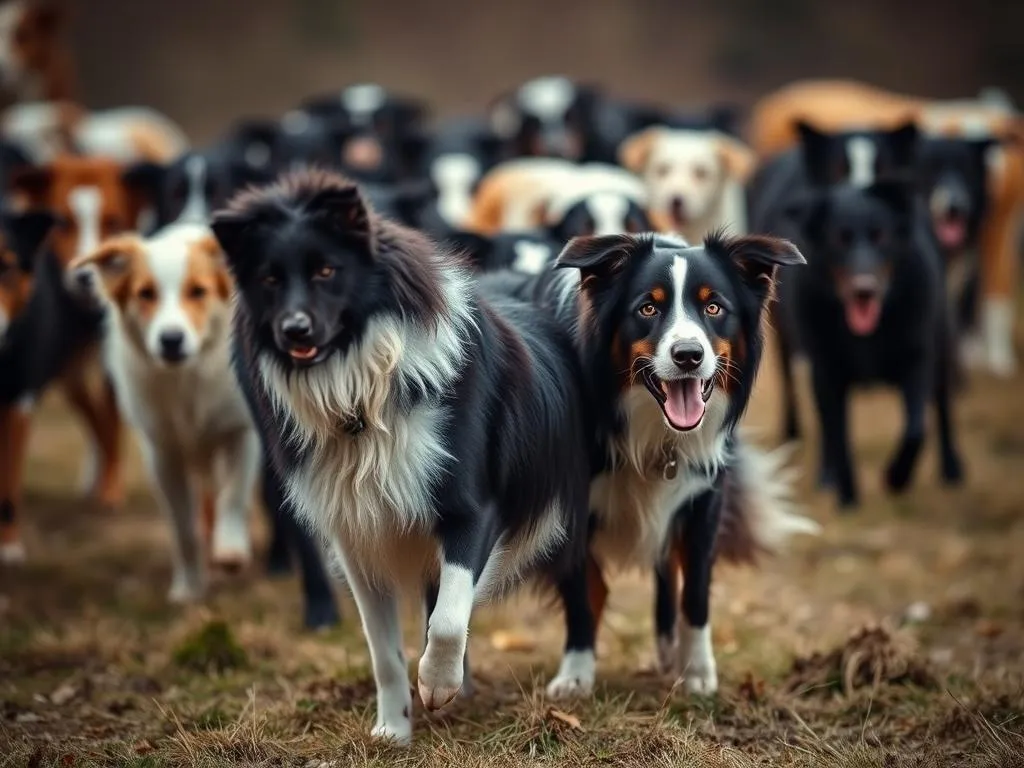
Introduction
Border Collies are widely recognized as one of the most intelligent and energetic dog breeds. With their incredible herding instincts, these dogs have been trusted by farmers and ranchers for generations to manage livestock. However, how to train a Border Collie to herd effectively requires an understanding of their unique characteristics and training techniques. Proper training not only helps to harness their natural abilities but also ensures a harmonious relationship between the dog, the handler, and the livestock.
This article will provide insights into training methods, tips for overcoming common challenges, and an understanding of the breed’s history and traits. Whether you’re a new Border Collie owner or an experienced trainer looking to refine your skills, this comprehensive guide will help you succeed in herding training.
Understanding the Breed
History of Border Collies
Border Collies have their origins in the border regions between England and Scotland. Initially bred for herding sheep, their lineage can be traced back to the Roman invasion in Britain, when they were used as working dogs. Over the years, selective breeding focused on enhancing their intelligence, agility, and herding instincts, making them exceptional at managing livestock.
The breed’s development was significantly influenced by the introduction of the working trial, which tested the herding skills of these dogs. This competitive spirit has led to the Border Collie being recognized as the quintessential herding dog, often excelling in various canine sports.
Physical and Behavioral Traits
Border Collies are medium-sized dogs, typically weighing between 30 to 45 pounds. Their sleek, athletic bodies allow them to exhibit high energy levels and remarkable agility. One of their defining characteristics is their intense focus and drive, which is essential for herding.
Behaviorally, Border Collies exhibit traits such as intelligence, loyalty, and an eagerness to please. They are natural problem solvers, often displaying herding behaviors like stalking and gathering, which make them highly effective in managing livestock. Understanding these traits is crucial in the training process, as it helps to tailor your approach to their needs.
Preparing for Training
Assessing Your Dog’s Readiness
Before embarking on herding training, it’s essential to assess your Border Collie’s readiness. Ideally, dogs should be at least six months old, as they need to have reached a certain level of maturity to understand commands and engage in physical activities. Additionally, it’s vital to ensure your dog is in good health and physically fit. A vet check can help rule out any underlying health issues that may hinder training progress.
Essential Equipment
Having the right tools can significantly enhance your training experience. Here are some essential items you might need:
- Whistle: A training whistle is crucial for long-distance commands and helps control your dog during herding.
- Leash: A sturdy leash is important for initial training and control.
- Safety Gear: Depending on the livestock you are working with, safety gear may include protective equipment for both the dog and the handler.
Investing in quality equipment will create a safer and more effective training environment.
Setting Training Goals
Setting clear training goals is essential for tracking progress. Break your objectives into short-term and long-term goals. For example, a short-term goal might be to teach basic commands like “sit” and “stay,” while a long-term goal could involve successfully herding livestock in a controlled environment. Understanding what success looks like will help you stay motivated and focused during the training process.
Basic Training Techniques
Obedience Training
Fundamental commands are the backbone of all training, including herding. Teaching your Border Collie commands such as “sit,” “stay,” and “come” is essential for establishing communication and control.
Step-by-step guide to teaching basic commands:
-
Sit: Hold a treat above your dog’s head and slowly move it back. As they follow the treat, their bottom will naturally lower. Once seated, say “sit,” and reward them.
-
Stay: Command your dog to sit, then take a step back. If they hold the position, reward them. Gradually increase the distance and duration.
-
Come: Use a long leash initially, call your dog’s name followed by “come.” Reward them when they reach you.
Repetition and positive reinforcement are key to successful obedience training.
Socialization Skills
Socialization is crucial for your Border Collie’s development. Exposing your dog to various environments, animals, and people helps reduce anxiety and prepares them for herding.
Tips for effective socialization:
- Introduce them to different animals progressively.
- Visit parks or public spaces to expose them to various sounds and experiences.
- Encourage friendly interactions with other dogs to build confidence.
The more experiences your dog has, the better equipped they will be for herding tasks.
Building Focus and Attention
Developing your dog’s focus is essential during training sessions. A distracted dog will struggle to learn commands or tasks effectively.
Techniques to improve concentration:
- Short Training Sessions: Keep sessions to 5-10 minutes to maintain their attention.
- Interactive Games: Use engaging games like fetch or tug-of-war to build focus and reinforce commands.
Regularly practicing focus exercises will help enhance your dog’s engagement and performance during herding training.
Introduction to Herding
Understanding Herding Instincts
Every Border Collie has inherent herding instincts, but recognizing and nurturing these behaviors is vital. Look for signs such as stalking, circling, or gathering.
Exercises to encourage natural herding instincts:
- Chasing a Ball: Use a ball to mimic the movement of livestock, allowing your dog to practice herding behaviors.
- Controlled Play with Other Dogs: Engage your dog in play with other dogs, allowing them to practice their instincts in a controlled environment.
Recognizing and encouraging these instincts early will set the foundation for successful herding training.
Using Stock and Controlled Environments
When introducing herding exercises, it’s important to choose the right animals and environments. Sheep are the most common choice for training, but ducks or goats can also be used.
Characteristics of a safe training environment:
- Fenced Areas: A secure, fenced space is essential to prevent livestock from escaping and to keep your dog focused.
- Controlled Groups: Start with a small number of animals to avoid overwhelming your dog.
Creating a safe and controlled environment will enhance the training experience for both you and your Border Collie.
Advanced Herding Techniques
Teaching Herding Commands
Once your dog has a solid foundation, it’s time to teach specific herding commands. Essential commands include “lie down,” “walk up,” “away,” and “come-bye.”
Methods to reinforce these commands:
- Lie Down: Encourage your dog to lie down with a treat and reward them when they comply.
- Walk Up: Use a leash to guide your dog toward the livestock while commanding them to “walk up.”
- Away and Come-bye: Use directional commands while guiding your dog around the livestock, rewarding them for following the command.
Reinforcement through practice and rewards is crucial for mastering these commands.
Working with Livestock
Working effectively with livestock requires patience and timing. Start with basic tasks, gradually increasing the complexity as your dog becomes more comfortable.
Strategies for effective livestock management:
- Observation: Watch your dog’s body language and reactions to livestock, adjusting your commands accordingly.
- Timing: Give commands at the right moment to help your dog understand what you expect.
Utilizing these strategies will enhance your dog’s confidence and ability to manage livestock effectively.
Troubleshooting Common Issues
Training may not always go as planned. Common challenges include chasing, aggression, or disobedience.
Techniques to redirect negative behaviors:
- Redirecting Focus: Use a toy or treat to redirect your dog’s focus if they become too excited or aggressive.
- Calm Commands: Remain calm and assertive, using commands to regain control of the situation.
Understanding these issues and having a plan to address them can help create a smoother training experience.
Continuing Education and Competition
Finding Training Resources
Continuous learning is essential in dog training. Look for books, online courses, or local trainers specializing in herding.
Recommended resources:
- Books: Seek out reputable dog training books that focus on herding techniques.
- Herding Clubs: Joining local herding clubs or organizations can provide valuable training opportunities and resources.
Networking with fellow trainers can also offer support and insights into effective training methods.
Preparing for Herding Trials and Competitions
If you’re considering entering herding trials, understanding what to expect can help ease nerves.
Tips for training leading up to competition:
- Practice Regularly: Consistent practice will build your dog’s confidence and skills.
- Mock Trials: Conduct mock trials at home to simulate the competition environment.
Familiarizing your dog with the competition setting will help them perform at their best.
Conclusion
Training a Border Collie to herd is a rewarding journey that requires patience, understanding, and consistent practice. By following the outlined steps, you can harness their natural abilities and foster a strong bond with your dog. Remember to celebrate small successes along the way and maintain a positive attitude throughout the training process. With dedication and the right techniques, you will be well on your way to effectively training your Border Collie to herd.
FAQs
What age should I start training my Border Collie for herding?
It’s best to start training your Border Collie for herding when they are at least six months old, as this age provides the maturity needed to understand commands.
How can I tell if my Border Collie has herding instincts?
Look for behaviors such as stalking, circling, or gathering objects. These instincts indicate a natural tendency to herd.
Are there specific breeds of livestock that are better for training?
Sheep are commonly used for training due to their manageable size and behavior. However, ducks or goats can also provide good training experiences.
What if my dog shows aggressive behavior during herding?
If your dog displays aggressive behavior, it’s important to redirect their focus using commands or toys and to remain calm. Consider consulting a professional trainer for additional guidance.









